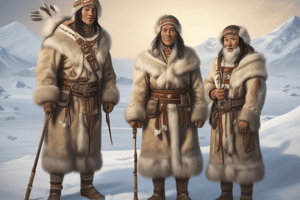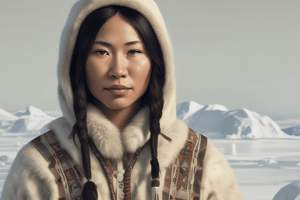Podcast
Questions and Answers
What characterizes the winter months in the Far North?
What characterizes the winter months in the Far North?
- Very dark and cold with moonlight on the ice (correct)
- Seasonal rains and frequent sunlight
- Short periods of darkness and cold
- Warm temperatures and long days
How long has the group known as the Inuit been in North America?
How long has the group known as the Inuit been in North America?
- More than 10,000 years
- Approximately 2,500 years (correct)
- Since the Ice Age
- About 15,000 years
What primary activities did the Inuit rely on for their survival when they first arrived?
What primary activities did the Inuit rely on for their survival when they first arrived?
- Gathering crops and livestock raising
- Farming and trading
- Hunting and fishing (correct)
- Construction and mining
What does the term 'Inuit' mean?
What does the term 'Inuit' mean?
How many days a year are warm enough for water not to freeze in the Far North?
How many days a year are warm enough for water not to freeze in the Far North?
Which description best fits the Far North's climate during summer?
Which description best fits the Far North's climate during summer?
What is a significant challenge of living in the northern land described?
What is a significant challenge of living in the northern land described?
What types of vegetation can be found during the short summer in the Far North?
What types of vegetation can be found during the short summer in the Far North?
What is a modern transportation method that many Inuit use today?
What is a modern transportation method that many Inuit use today?
What material is commonly used for modern Inuit kayaks?
What material is commonly used for modern Inuit kayaks?
What do many Inuit continue to observe despite modern advancements?
What do many Inuit continue to observe despite modern advancements?
How do Inuit families prepare for the year in terms of food?
How do Inuit families prepare for the year in terms of food?
Which of the following describes a characteristic of modern Inuit communities?
Which of the following describes a characteristic of modern Inuit communities?
What material did the Inuit primarily use to make tools due to a lack of trees in the Arctic?
What material did the Inuit primarily use to make tools due to a lack of trees in the Arctic?
How did the Inuit typically build shelters during their migrations?
How did the Inuit typically build shelters during their migrations?
What significant hunting technology did the Inuit learn from other peoples in northern Asia?
What significant hunting technology did the Inuit learn from other peoples in northern Asia?
What was the primary transportation method for the Inuit when traveling on sea?
What was the primary transportation method for the Inuit when traveling on sea?
What change in climate affected the ability of the Inuit to live in one place after a thousand years ago?
What change in climate affected the ability of the Inuit to live in one place after a thousand years ago?
What materials were primarily used for constructing the frames of kayaks by the Inuit?
What materials were primarily used for constructing the frames of kayaks by the Inuit?
What special tools did the Inuit use for hunting large marine animals?
What special tools did the Inuit use for hunting large marine animals?
What was a significant outcome of the Inuit's adaptation to their environment?
What was a significant outcome of the Inuit's adaptation to their environment?
What type of animal did the Inuit primarily hunt during the winter?
What type of animal did the Inuit primarily hunt during the winter?
What unique shelter did the Inuit build using blocks of snow?
What unique shelter did the Inuit build using blocks of snow?
In which season did the Inuit travel to inland rivers to fish for trout?
In which season did the Inuit travel to inland rivers to fish for trout?
What structure did the Inuit use to carry heavy loads?
What structure did the Inuit use to carry heavy loads?
What material was primarily used to build shelters near the coast in the fall?
What material was primarily used to build shelters near the coast in the fall?
What was one of the main food sources for the Inuit during summer?
What was one of the main food sources for the Inuit during summer?
What did the Inuit burn for light and heat in their shelters?
What did the Inuit burn for light and heat in their shelters?
What adaptation did Inuit families make in summer regarding their living arrangements?
What adaptation did Inuit families make in summer regarding their living arrangements?
Flashcards are hidden until you start studying
Study Notes
The Inuit and Their Environment
- The Arctic environment is characterized by six months of long periods of light and six months of long periods of darkness.
- Winters are extremely dark and cold; summers are short, with only about 100 days warm enough to prevent water from freezing.
- The lack of trees means that the Inuit utilize driftwood for construction purposes.
- The Arctic is described as a "frozen desert," a challenging environment for human habitation.
Inuit Origins and Early Life
- Inuit ancestors arrived in North America approximately 2,500 years ago, unrelated to the earlier hunter-gatherers of the land bridge between Asia and North America (at least 15,000 years ago).
- The word "Inuit" means "the people."
- Initially, the Inuit relied on hunting, fishing, and gathering plants during the short summer for sustenance. They crafted tools from bones and flint.
- Around 2,000 years ago, they adopted the use of bows and arrows from northern Asian peoples.
Inuit Adaptation and Migration
- About 1,000 years ago, a warmer climate allowed whales to migrate along the Arctic coast; some Inuit groups followed them east from Alaska, establishing villages.
- Kayaks proved essential for sea travel, while sleds pulled by people or dogs facilitated land travel.
- They became skilled hunters of whales and walruses, using harpoons with bone, stone, and later iron tips.
- A colder climate 500 years ago forced the Inuit to return to a nomadic lifestyle, hunting smaller animals and adapting to a colder environment.
- Some Inuit engaged in trade with European explorers.
Inuit Seasonal Practices and Structures
- During winter, the Inuit hunted caribou and seals, using snow to build igloos – sometimes connected by halls and tunnels. Families gathered for shared activities.
- Spring brought inland fishing and the use of kayaks as ice melted.
- Animal hide tents replaced igloos in summer, and plants and berries supplemented their diet.
- Fall saw the return to the coast for hunting seals, walruses and whales, and shelters made from rock-lined pits.
- Whale or seal fat provided light, heat, and cooking fuel.
- Food storage and preservation techniques were essential.
Modern Inuit Life
- Many Inuit now live in communities similar to other modern communities, using modern transportation, materials, and clothing, while also maintaining many ancient traditions.
- The strong ties to the land, sea and animals remain significant.
Studying That Suits You
Use AI to generate personalized quizzes and flashcards to suit your learning preferences.




